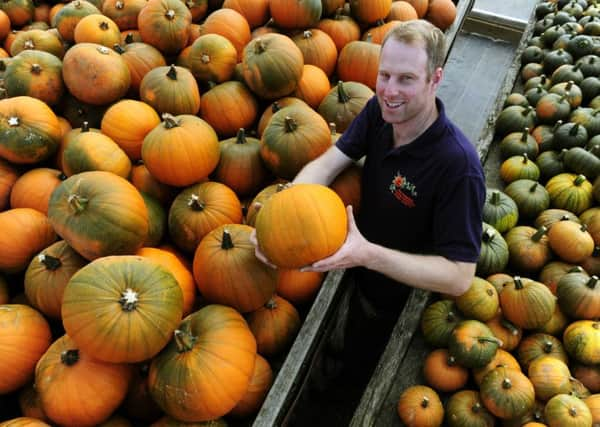Orange is the colour of autumn East Yorkshire fruit farmer


TV chefs such as Antony Worrall Thompson have started making use of pumpkins too, and for its real purpose, recipes for pumpkin pie and soup. While its main reason for purchase remains of a short-term ornamental nature the reawakening as an edible source is also an encouragement to growers.
Jason Butler combines his work as a self-employed agricultural engineer with running his parents’ 60-acre Homeland Farm in Bewholme, near Hornsea where he has five acres of his own. He grows winter wheat, winter beans and for the past five years has developed his own pumpkin growing business, The Pumpkin Patch. October is his and every other grower’s big month and his display at the farm is eye catching.
Advertisement
Hide AdAdvertisement
Hide Ad“When I was about 12-years-old I grew some and sold them for pocket money by the roadside. It wasn’t until recently that I started again with just a quarter of an acre of them. I had 1,000 pumpkins that year and planted them all by hand. I rang and visited farm shops, grocery retailers and farm attractions and sold the lot. The following year I invested in a two-row planting machine and upped the number grown to 5,000.
“Last year I had a crop of 14,000 and felt that was about the tops I would go to but this year I have 18,000. It was a bit of a gamble, but it’s all about growing a decent crop and trying to market it. I have some good, loyal customers including trade buyers and farm shops, plus we put on our own display here that always looks good. We also purposely grow a few by the roadside so that people can see them growing and ripening. That helps with our passing trade.
“Supermarkets have played a big part in the pumpkin revival as Halloween gives them another event to focus on between summer and Christmas, and while a lot of what is bought will only be used to carve up and make lanterns, we use them a lot ourselves for soups and pies. My favourite is pumpkin soup with bacon. We also supply restaurants such as Tickton Grange and we will have a stall at the Beverley Food Festival on Sunday.”
Jason starts planting the pumpkin seeds under cover during early to mid-April in order to protect them and get them going, but by the end of May when the ground is frost-free he gets them all planted outside in an area that now covers between five and six acres. This usually takes place around the second bank holiday weekend in May.
Advertisement
Hide AdAdvertisement
Hide Ad“We grow three main varieties - Mars, Magician and Gladiator. I’ve tried several over the years but these work best. They grow on a trailing vine planted into the top of the soil and have a good root system that can cover a large area. The ones we grow are more of a bush-type plant that doesn’t take up too much room and we get either one or two pumpkins per plant. The plant has male and female flowers and they need bees to pollenate them. We rely on wild bees as we don’t have any of our own, but we do have enough clover and other wild flowers that attract them.
“Within a few weeks of being out in the fields, given the right amount of sunshine and rain, they will swell up to quite a fair size. They do need plenty of water and they don’t do as well without the pollination from the bees even though some will self-pollinate.
“Harvesting is a big job and the whole family is involved including my girlfriend Becky, mum and dad Lesley and Mike, my sisters Sheree and Mikaela and their partners. In late-September we cut the pumpkins off the vine and leave them in the field a week to let them cure. This helps the skin and dries out the stalk. The vine then dies off. So far we’ve cut half of the crop and we will cut the rest during the next few weeks and pick what we need to fulfil the orders.”
Having not had any particular vision over how the business would take off Jason has now increased his volume 18-fold since his first crop. He now wears an embroidered shirt with a The Pumpkin Patch motif and supplies the likes of York Maze, William’s Farm Shop in Hornsea and Rafters in Driffield. So is this the start of something much bigger?
Advertisement
Hide AdAdvertisement
Hide Ad“My granddad used to have a small farm here with a few dairy cows. My dad, who’s a joiner by trade, has always had a keen interest in farming and that’s why we’ve added to our acreage. I like farming and was brought up with it so it is good to carry on, but at the same time 60 acres isn’t enough to live off. It’s my engineering side that pays the bills at the moment but I’d like to expand the farming side more so who knows?
“We grow the Relay variety of feed wheat and that has done well coming in at a good average of four tonnes over the 30 acres. It doesn’t go too far from the farm at all, to Elliott’s Eggs just 100 yards away to be milled as chicken feed. The winter beans account for three to four acres and we harvest haylage too.”
Jason’s mindset in October is however on one crop only.
“If we’re not pretty much sold out by October 31 you know you’ve missed the boat.”